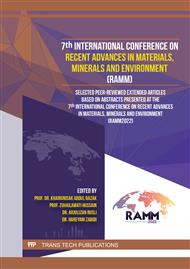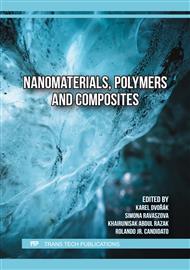[1]
C. Pownraj and A. Valan Arasu, "Effect of dispersing single and hybrid nanoparticles on tribological, thermo-physical, and stability characteristics of lubricants: a review," Journal of Thermal Analysis and Calorimetry, vol. 143, no. 2, p.1773–1809, Jan. 2021.
DOI: 10.1007/s10973-020-09837-y
Google Scholar
[2]
Ü. Ağbulut, Understanding the role of nanoparticle size on energy, exergy, thermoeconomic, exergoeconomic, and sustainability analyses of an IC engine: A thermodynamic approach, Fuel Processing Technology, vol. 225, Jan. 2022.
DOI: 10.1016/j.fuproc.2021.107060
Google Scholar
[3]
Z. Mingzheng, X. Guodong, L. Jian, C. Lei, and Z. Lijun, "Analysis of factors influencing thermal conductivity and viscosity in different kinds of surfactant solutions," Experimental Thermal and Fluid Science, vol. 36, p.22–29, Jan. 2012.
DOI: 10.1016/j.expthermflusci.2011.07.014
Google Scholar
[4]
M. A. Khairul, K. Shah, E. Doroodchi, R. Azizian, and B. Moghtaderi, "Effects of surfactant on stability and thermo-physical properties of metal oxide nanofluids," International Journal of Heat and Mass Transfer, vol. 98, p.778–787, Jul. 2016
DOI: 10.1016/j.ijheatmasstransfer.2016.03.079
Google Scholar
[5]
A. K. Rasheed, M. Khalid, W. Rashmi, T. C. S. M. Gupta, and A. Chan, "Graphene based nanofluids and nanolubricants - Review of recent developments," Renewable and Sustainable Energy Reviews, vol. 63. Elsevier Ltd, p.346–362, Sep. 01, 2016.
DOI: 10.1016/j.rser.2016.04.072
Google Scholar
[6]
M. Sandhya, D. Ramasamy, K. Sudhakar, K. Kadirgama, and W. S. W. Harun, "Ultrasonication an intensifying tool for preparation of stable nanofluids and study the time influence on distinct properties of graphene nanofluids – A systematic overview," Ultrasonics Sonochemistry, vol. 73. Elsevier B.V., May 01, 2021.
DOI: 10.1016/j.ultsonch.2021.105479
Google Scholar
[7]
Hasan Nia, M., Rezaei-Tavirani, M., Reza Nikoofar, A., Masoumi, H., Nasr, R., Hasanzadeh, H., Jadidi, M., & Shadnush, M. (2015). Stabilizing and dispersing methods of TiO 2 nanoparticles in biological studies. In Journal of Paramedical Sciences (JPS) Spring (Vol. 6, Issue 2).
Google Scholar
[8]
A. Asadi, I. M. Alarifi, V. Ali, and H. M. Nguyen, "An experimental investigation on the effects of ultrasonication time on stability and thermal conductivity of MWCNT-water nanofluid: Finding the optimum ultrasonication time," Ultrasonics Sonochemistry, vol. 58, Nov. 2019.
DOI: 10.1016/j.ultsonch.2019.104639
Google Scholar
[9]
Shi, G., Araby, S., Gibson, C. T., Meng, Q., Zhu, S., & Ma, J. (2018). Graphene Platelets and Their Polymer Composites: Fabrication, Structure, Properties, and Applications. In Advanced Functional Materials (Vol. 28, Issue 19). Wiley-VCH Verlag
DOI: 10.1002/adfm.201706705
Google Scholar
[10]
F. Yu et al., Dispersion stability of thermal nanofluids, Progress in Natural Science: Materials International, vol. 27, no. 5. Elsevier B.V., p.531–542, Oct. 01, 2017.
DOI: 10.1016/j.pnsc.2017.08.010
Google Scholar
[11]
M. Sandhya, D. Ramasamy, K. Sudhakar, K. Kadirgama, and W. S. W. Harun, Ultrasonication an intensifying tool for preparation of stable nanofluids and study the time influence on distinct properties of graphene nanofluids – A systematic overview, Ultrasonics Sonochemistry, vol. 73. Elsevier B.V., May 01, 2021.
DOI: 10.1016/j.ultsonch.2021.105479
Google Scholar
[12]
Afzal, A., Nawfal, I., Mahbubul, I. M., & Kumbar, S. S. (2019). An overview on the effect of ultrasonication duration on different properties of nanofluids. Journal of Thermal Analysis and Calorimetry, 135(1), 393–418
DOI: 10.1007/s10973-018-7144-8
Google Scholar
[13]
Kamalgharibi, M., Hormozi, F., Zamzamian, S. A. H., & Sarafraz, M. M. (2016). Experimental studies on the stability of CuO nanoparticles dispersed in different base fluids: influence of stirring, sonication and surface active agents. Heat and Mass Transfer/Waerme- Und Stoffuebertragung, 52(1), 55–62
DOI: 10.1007/s00231-015-1618-z
Google Scholar
[14]
D. P. Barai, B. A. Bhanvase, and G. Żyła, Experimental investigation of thermal conductivity of water-based FE3O4 nanofluid: An effect of ultrasonication time, Nanomaterials, vol. 12, no. 12, p.1961, 2022.
DOI: 10.3390/nano12121961
Google Scholar
[15]
R. Sadeghi, S. G. Etemad, E. Keshavarzi, and M. Haghshenasfard, Investigation of alumina nanofluid stability by UV–vis spectrum, Microfluidics and Nanofluidics, vol. 18, no. 5-6, p.1023–1030, 2014.
DOI: 10.1007/s10404-014-1491-y
Google Scholar
[16]
Yu, W., Xie, H., Li, Y., & Chen, L. (2011). Experimental investigation on thermal conductivity and viscosity of aluminum nitride nanofluid. Particuology, 9(2), 187–191
DOI: 10.1016/j.partic.2010.05.014
Google Scholar
[17]
Y. Zhai, L. Li, J. Wang, and Z. Li, Evaluation of surfactant on stability and thermal performance of al2o3-ethylene glycol (EG) nanofluids, Powder Technology, vol. 343, p.215–224, 2019.
DOI: 10.1016/j.powtec.2018.11.051
Google Scholar
[18]
Z. A. Ghaleb, M. Mariatti, and Z. M. Ariff, Properties of graphene nanopowder and multi-walled carbon nanotube-filled epoxy thin-film nanocomposites for electronic applications: The effect of sonication time and filler loading, Composites Part A: Applied Science and Manufacturing, vol. 58, p.77–83, 2014.
DOI: 10.1016/j.compositesa.2013.12.002
Google Scholar
[19]
P. G. Kumar, V. Kumaresan, and R. Velraj, Stability, viscosity, thermal conductivity, and electrical conductivity enhancement of multi-walled carbon nanotube nanofluid using Gum Arabic, Fullerenes, Nanotubes and Carbon Nanostructures, vol. 25, no. 4, p.230–240, 2017.
DOI: 10.1080/1536383x.2017.1283615
Google Scholar
[20]
P. Anju, B. Aryanandiny, S. K. Amizhtan, R. L. Gardas, and R. Sarathi, Investigation on the electrical and Rheological Properties of ALN-based synthetic ester nanofluids, IEEE Access, vol. 10, p.37495–37505, 2022.
DOI: 10.1109/access.2022.3163374
Google Scholar
[21]
A. Kumar and C. K. Dixit, Methods for characterization of nanoparticles, Advances in Nanomedicine for the Delivery of Therapeutic Nucleic Acids, p.43–58, 2017.
DOI: 10.1016/b978-0-08-100557-6.00003-1
Google Scholar



